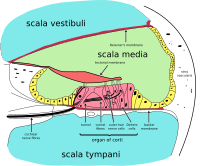
Photo from wikipedia
Introduction: We aimed to compare the effectiveness of wideband absorbance in detecting ossicular chain discontinuity with intraoperative findings. Materials and Methods: In this study, 58 ears from 38 patients with… Click to show full abstract
Introduction: We aimed to compare the effectiveness of wideband absorbance in detecting ossicular chain discontinuity with intraoperative findings. Materials and Methods: In this study, 58 ears from 38 patients with chronic otitis media (COM) were included. Twenty-six ears with perforation and intact ossicular chain were determined as Group 1, 12 ears with perforation and ossicular chain defects were determined as Group 2, and 20 ears with normal hearing and intact tympanic membrane were determined as Group 3. The comparison of the groups was made considering the static (non-pressure) absorbance analysis performed using wideband tympanometry. Results: When perforation sites were evaluated in Group 1 and Group 2; there were 12 anterior perforations, 7 posterior perforations, and 19 subtotal perforations. Air conduction thresholds in Group 2 were significantly (P<0.05) higher than in Group 1, as expected in pure tone audiometry. When wideband absorbance (WBA) measurements were evaluated in all 3 groups, no significant difference (P>0.05) was found between the frequencies 226 to 1000 Hz. WBA measurements at 8 frequencies between 1888-2311 Hz in Group 1 were significantly lower than Group 3 (P<0.05). WBA measurements at 4 frequencies between 3462-3886 Hz frequencies in Group 2 were significantly lower than Group 1 (P<0.05). Conclusions: Our findings concluded that a significant decrease in absorbance values in the narrow frequency range may be valuable in predicting ossicular chain defects.
Journal Title: Iranian Journal of Otorhinolaryngology
Year Published: 2022
Link to full text (if available)
Share on Social Media: Sign Up to like & get
recommendations!